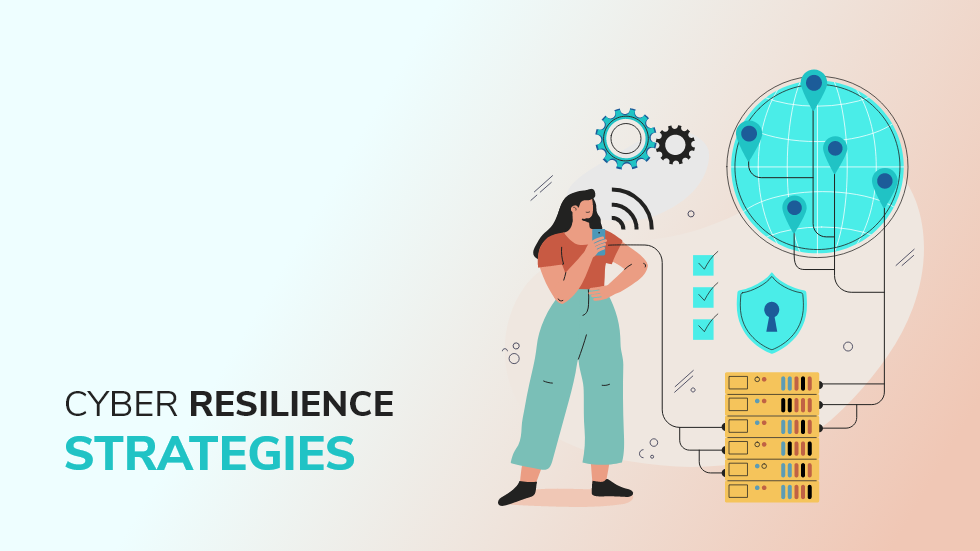In an increasingly interconnected world, businesses face a myriad of cyber threats that can disrupt operations, compromise sensitive data, and undermine customer trust. However, amidst these challenges lies an opportunity for organizations to bolster their defenses and emerge stronger than ever.
By embracing the concept of cyber resilience and implementing effective strategies, businesses can proactively navigate the ever-evolving threat landscape, mitigate risks, and swiftly recover from cyber incidents. But, to understand the importance of these strategies, we must first understand what cyber resilience is and what common cyber threats businesses face today.
Understanding Cyber Resilience
Cyber resilience is an organization’s capacity to anticipate, withstand, respond to, and recover from cyber threats while maintaining its critical information assets’ confidentiality, integrity, and availability. It goes beyond traditional cybersecurity measures, primarily focusing on prevention and defense. Cyber resilience emphasizes the ability to adapt, recover, and continue operating in the face of cyber-attacks and incidents.
The importance of cyber resilience cannot be overstated in today’s digital landscape. Cyber-attacks have become more sophisticated and prevalent, with organizations of all sizes and industries falling victim to breaches and disruptions. The consequences of such incidents extend far beyond financial losses, often resulting in reputational damage, legal liabilities, and loss of customer trust. By embracing cyber resilience, businesses can minimize the impact of cyber incidents, ensure business continuity, and safeguard their competitive edge.
Common Types of Cyber Attacks

To truly understand the significance of cyber resilience, we must familiarize ourselves with the common types of cyber-attacks that organizations face. These attacks are constantly evolving and becoming more sophisticated, making it crucial for businesses to stay ahead of the curve.
- Phishing Attacks:
Phishing attacks involve fraudulent emails, messages, or websites that trick individuals into revealing sensitive information, such as login credentials or financial details. These attacks often rely on social engineering tactics and exploit human vulnerabilities. - Malware Attacks:
Malware refers to malicious software designed to disrupt, damage, or gain unauthorized access to computer systems. It includes viruses, ransomware, spyware, and trojans. Malware can enter systems through various vectors, such as email attachments, infected websites, or removable media. - Denial-of-Service (DoS) Attacks:
Denial-of-Service attacks overload a system or network, making it unavailable to users. Attackers flood the target with a high volume of traffic or requests, causing disruptions in service and impacting business operations. - Social Engineering Attacks:
Social engineering attacks exploit human psychology to manipulate individuals into divulging sensitive information or performing actions that compromise security. This can include tactics like impersonation, pretexting, or baiting. - Insider Threats:
Insider threats involve malicious actions or negligence by individuals within an organization who have authorized access to systems and data. They can intentionally or unintentionally cause harm to the organization’s security by leaking sensitive information or misusing their privileges. - Advanced Persistent Threats (APTs):
APTs are sophisticated, targeted attacks that involve a prolonged and stealthy presence within a network, aimed at extracting valuable information or conducting espionage. APTs are highly coordinated and often backed by well-resourced threat actors.
10 Essential Strategies for Cyber Resilience

To build a strong cyber resilience plan, businesses must adopt and implement various strategies. These strategies work in tandem to create a layered defense system that addresses vulnerabilities, detects threats, and enables swift response and recovery. Here are some essential strategies to consider:
1. Develop a Comprehensive Security Framework:
Establish a robust security framework encompassing preventive measures, detection capabilities, and incident response protocols. This includes implementing firewalls, antivirus software, and intrusion detection systems to protect your network. Conduct regular vulnerability assessments and penetration testing to identify and address potential weaknesses.
2. Educate and Train Your Employees:
Human error remains one of the biggest vulnerabilities in cybersecurity. Educate your employees about best practices for data protection, such as creating strong passwords, identifying phishing attempts, and practicing safe browsing habits. Conduct regular training sessions to update your workforce on emerging threats and provide them with the necessary skills to contribute to your organization’s cyber resilience.
3. Implement Secure Backup and Recovery Solutions:
Regularly back up your critical data and systems to secure offsite locations or cloud-based platforms. Ensure your backup solutions are periodically tested and easily accessible to facilitate swift data recovery during a cyber incident. A reliable backup system is crucial for minimizing downtime and maintaining business continuity.
4. Enforce Access Controls and Privilege Management:
Implement strict access controls to limit user privileges and grant access only to authorized personnel. Implement multi-factor authentication and strong password policies to enhance security. Regularly review and update user permissions to ensure employees have access rights based on their roles and responsibilities.
5. Continuously Monitor and Detect Threats:
Deploy advanced real-time threat detection and monitoring tools to identify potential cyber threats. Implement security information and event management (SIEM) systems that provide comprehensive visibility into your network, enabling you to promptly detect and respond to incidents. Monitor network traffic, system logs, and user activities to identify suspicious behavior or anomalies that may indicate a cyber-attack.
6. Develop an Incident Response Plan:
Prepare and document a detailed incident response plan that outlines the steps to be taken during a cyber incident. Assign clear roles and responsibilities to team members and establish communication channels for efficient coordination. Regularly test and update your incident response plan to ensure its effectiveness and alignment with the evolving threat landscape.
7. Regularly Update and Patch Systems:
Keep your software, applications, and operating systems updated with the latest security patches and updates. Cyber attackers often exploit vulnerabilities in outdated software. Implement a patch management process to ensure timely updates across your IT infrastructure, reducing the risk of exploitation.
8. Conduct Regular Vulnerability Assessments:
Perform regular vulnerability assessments to identify and remediate potential weaknesses in your systems. Use automated scanning tools or engage the services of cybersecurity professionals to conduct comprehensive inspections. Address identified vulnerabilities promptly to minimize the risk of exploitation by attackers.
9. Implement Strong Password Policies and Multi-Factor Authentication:
Require employees to use strong, unique passwords for all their accounts. Encourage the use of password managers to store and generate secure passwords. Additionally, enable multi-factor authentication (MFA) wherever possible, adding an extra layer of protection by requiring users to provide additional verification beyond their passwords.
10. Engage in Threat Intelligence and Information Sharing:
Stay informed about the latest cyber threats by actively engaging in threat intelligence and information-sharing initiatives. Collaborate with industry peers, government organizations, and cybersecurity communities to exchange threat intelligence and insights. This collective knowledge can help you identify emerging threats and enhance your cyber resilience strategies.
By implementing these essential strategies, businesses can strengthen their cyber resilience, minimize vulnerabilities, and effectively respond to and recover from cyber incidents. Remember, cyber resilience is an ongoing effort that requires continuous evaluation, adaptation, and investment in the right resources to keep pace with evolving threats.
Conclusion
By adopting a proactive approach to cyber resilience and implementing these essential strategies, businesses can fortify their defenses, minimize the impact of cyber-attacks, and ensure the continuity of their operations. The journey toward cyber resilience requires ongoing vigilance, adaptability, and investment in the right resources. Embrace the power of cyber resilience and secure your business’s future in an increasingly interconnected digital world.

Santiago Montoya, a seasoned DevOps engineer with a Eight-year tenure in the field, brings a wealth of experience. Santiago is a true visionary in the tech realm and holds the Global Director of Technology position at TechGenies. His expertise spans diverse domains, from cybersecurity and solution architecture to IT cost optimization. As a HIPAA-certified AWS Solutions Architect, he ensures top-tier security and architects robust solutions that transcend industry standards. Santiago is the driving force behind TechGenies’ technological prowess, orchestrating a symphony of innovation and efficiency.
Connect with Santiago to explore the intricacies of modern technology leadership and discover how he continues to shape the landscape of IT excellence.



